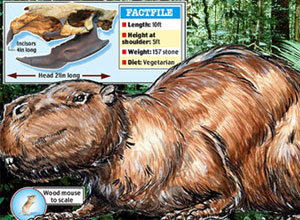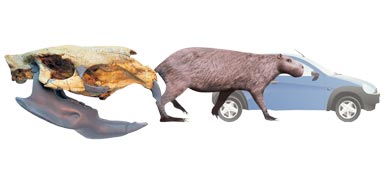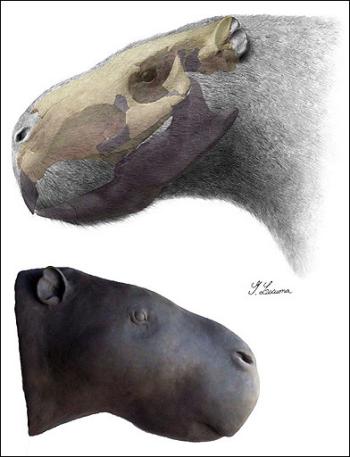Giant Fossil Rodent Discovered
Posted by: Loren Coleman on January 15th, 2008

Along with other media outlets, The Times of London, through environment reporter Lewis Smith, is noting for January 16, 2008, the details of what is being characterized as a “giant rat” fossil find in South America.

The skull of the rodent is 53cm long. The creature had huge incisors that may have been used for felling trees or fighting.

Reconstruction of the largest fossil rodent, Josephoartigasia monesi.
The fossilised skull of a rat the size of a car has been unearthed. The creature lived about four million years ago, weighed about a tonne and ate mostly soft vegetation. It was so big that it probably spent much of its life semi-submerged in water, like a hippo, to reduce the stresses caused by its size.
Palaeontologists found the skull in rock deposits in Uruguay. It is believed to date back two to four million years to a time when giant wildlife was commonplace in South America.
The rodent, Josephoartigasia monesi, was uncovered by Andrés Rinderknecht and Ernesto Blanco. It has been nicknamed Mighty Mouse and is thought to have been similar to the capybara and pacarana, much smaller creatures that are still found in South America. Capybaras are the biggest living rodents at just over 60kg fully grown, while pacaranas weigh 15kg. The common rat weighs about 300g.
J. monesi is thought to have weighed about a tonne and the biggest specimens could have been more than 2.5 tonnes — about the same as hippopotamuses, which range from 1.4 tonnes to 3.2 tonnes.
The rodent was estimated to be about 3m (10 feet) long and 1.5m tall. Its huge incisors were more than 30cm (12in) long, of which 10cm would have been exposed.
The incisors puzzled the researchers because they were much tougher than necessary for an animal that ate only soft plants. Dr Blanco suggested that they could have been used to fell trees like beavers do, or to fight off predators or courtship rivals.
“It probably ate aquatic plants and fruits, and the environment probably was a forest near fresh water,” Dr Blanco said. “But much work is needed to have a definitive picture. We are working on biomechanical determination of the bite force to better understand this point.”
It shared the Earth with sabre-tooth cats and giant predatory birds that did not fly but could run down prey at terrifying speeds. Its great bulk would have protected it from the killer birds, but its young would have been at risk.
The near-complete skull delighted palaeontologists studying giant South American rodents. Before, they had been limited to bone fragments.
Other teeth in the skull were too small to have allowed the animal to have chewed food well. Researchers concluded that it must have consumed soft vegetation, including fruit.
Rodents make up about 40 per cent of all mammals but the new South American species was still about twice the size of the next biggest, a South American species called Phoberomys.
The skull came from a type of rodent, known as dinomyids, that include today’s pacaranas and which during the Miocene and Pliocene periods, from about 2 to 23 million years ago, underwent an evolutionary explosion creating many species in modern-day Argentina, Brazil, Uruguay, Venezuela, Bolivia and Colombia.
Dr Rinderknecht, of the National Museum of Natural History and Anthropology in Montevideo, the Uruguayan capital, and Dr Blanco, of the Institute of Physics in Montevideo, reported their findings in the journal Proceedings of the Royal Society B.
The Royal Society is Britain’s de-facto Academy of Sciences.
About Loren Coleman
Loren Coleman is one of the world’s leading cryptozoologists, some say “the” leading living cryptozoologist. Certainly, he is acknowledged as the current living American researcher and writer who has most popularized cryptozoology in the late 20th and early 21st centuries.
Starting his fieldwork and investigations in 1960, after traveling and trekking extensively in pursuit of cryptozoological mysteries, Coleman began writing to share his experiences in 1969. An honorary member of Ivan T. Sanderson’s Society for the Investigation of the Unexplained in the 1970s, Coleman has been bestowed with similar honorary memberships of the North Idaho College Cryptozoology Club in 1983, and in subsequent years, that of the British Columbia Scientific Cryptozoology Club, CryptoSafari International, and other international organizations. He was also a Life Member and Benefactor of the International Society of Cryptozoology (now-defunct).
Loren Coleman’s daily blog, as a member of the Cryptomundo Team, served as an ongoing avenue of communication for the ever-growing body of cryptozoo news from 2005 through 2013. He returned as an infrequent contributor beginning Halloween week of 2015.
Coleman is the founder in 2003, and current director of the International Cryptozoology Museum in Portland, Maine.










Just imagine the size of the trap to catch that big mutha! 🙂
It really does not look like a giant rat at all, but I guess “GIANT FOSSIL RAT” sounds a lot more exciting than “giant fossil capybara”.
I wonder if they were prey for Giant Fossil Cats ;)?
This is a fascinating find. Giganticism is a relatively common evolutionary route for a range of animals throughout the ages as it offers a whole slew of varied benefits even in light of the obvious drawback of having to acquire enough food to maintain such mass. I wonder what key environmental and selective pressures were present in this habitat in this particular case that made it advantageous for this rodent to develop such immense size? It is a very interesting topic for me.
That is one big rat!
The term “rat” is very misleading, as this animals had nearly no connection with rats. What would make at least more sense would be to call it a monster guinea pig, as this south american rodents are in fact closer related to this extinct brute than any rat.
Yes, indeed, as noted by others here. These fossil forms have a lot more in common with pacaranas, as the article mentions, and appear to look more like giant capybaras, than giant rats.
Therefore, I have revised the headline to this blog.